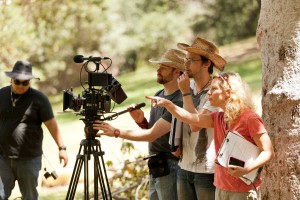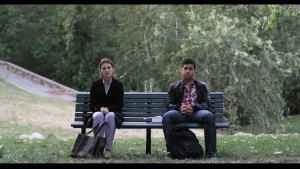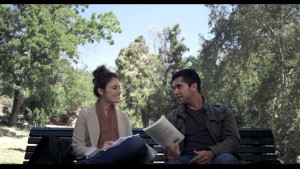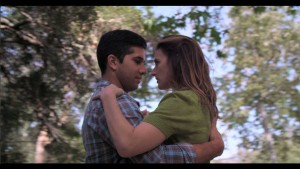
“The concept for the film was created so it would be makeable,” shared writer-director-producer Ann LeSchander. “That led to a short production schedule and a small crew. My production crew was small, but mighty. And they really were committed.”
The production was very contained, set primarily in one location, the Old Zoo area of Griffith Park. The location was chosen not only for its look and lack of pedestrian traffic, but also for the fact that a park ranger was not required to be on set, an expense the indie company could not afford.
Yet, despite what seemed like a simple idea to achieve, the practical application of that idea proved to be more complicated than it first appeared.
LeSchander did a lot of “horrible stick figure” storyboards to convey her vision to the key player in pre-production and production, director of photography Gareth Taylor. With essentially one location, the main challenge for Taylor was varying the shots and making the camera set-ups not only interesting, but also germane to the story arc by reflecting what was going on in the relationship as it progressed.

Because she likes movement in shots, LeSchander and Taylor planned numerous dolly shots. By day three they realized what “time-killers” those set-ups were, so they gave up on a lot of those dollies. “We had to do it judiciously,” said LeSchander. “We decided one a day. That was the only way we could make our day.”
Over the short week of shooting the team needed to make each of the different meetings look like they had taken place at different times from the end of January through June.
“I initially wanted the film to be nicely composed. I wanted it to be lovely. I didn’t want it to be hand-held,” explained LeSchander. “There was a lot of pre-production, a lot of figuring out. How could we cheat this to look like a semester has gone by? A lot of that had to do with what time of day we shot certain scenes and how we lit the colder, bluer look of the early months, which slowly got warmer and warmer.”
It might be assumed that little lighting was needed for an exterior location, but to achieve the passage of time over the six-month period of the story, lighting and filters were used. In addition, the color themes set during production were continued during color timing in post.
“There really were quite extensive lighting set-ups. Even though there were no lights, there were huge silks. Sometimes there would be a tent of the silks. Huge bounce cards, off in the distance. There was really quite a lot to do, even though we weren’t plugging in lights,” revealed LeSchander.
Wardrobe was another way to cheat the passage of time from cooler into warmer months. The script covered important moments during 45 meetings that take place on 45 different days.
 “I thought I’ll get two actors with great chops. I’ll put them on a park bench and then we’re off and running,” said LeSchander. “Then it was like, oh wait! Every time they come to the park bench, it’s a new day. She needs to look different. The shot needs to look different. The wardrobe needs to be different. And then the hair too.”
“I thought I’ll get two actors with great chops. I’ll put them on a park bench and then we’re off and running,” said LeSchander. “Then it was like, oh wait! Every time they come to the park bench, it’s a new day. She needs to look different. The shot needs to look different. The wardrobe needs to be different. And then the hair too.”
It helped that the actors shared a lot of their personal clothing with production, but costumer Sara Saldivar had to be very organized in order to track the multiple wardrobe changes – six or seven every day, based upon the seasonal weather and the emotion intent of each scene. Also for some scenes, such as the dance scene and the scene when Emily talks about the novel Ethan Frome, the director wanted the character to be dressed in something special.
“It was really a lot of work. They’d run to wardrobe. We’d set-up the next scene, because the lighting set-up would always change. The camera angle would always change. We didn’t have a lot of coverage. We tried to cover our scene in two or three shots. Sometimes it was a single shot,” said LeSchander.
The director credits her casting director Amey René Morris, with getting the right people. That got the project going at the very beginning. “She was fantastic. Once she was onboard, the thing was happening,” stated LeSchander.
Assistant director and unit production manager Judy Bafaro, was the director’s right-hand person. Although the director might have wanted a bit more coverage, they were able to get the film in the can by day seven.
“I just loved her. She came in and nailed it. She did a lot of organization. She made the day happen. She was fantastic,” said LeSchander. “It was a race. It was really go, go, go. Even with one location, everything has to be set-up just right.”
 Despite the single location, the production did not shoot in continuity. Because of the lighting quality needed for the different seasons, the early meetings were all shot early in the morning to get cooler light. Throughout the week, the director also spread out a series of monologues that served as narration to the animated and Super-8 flashbacks, or scenes that included “special guest stars”.
Despite the single location, the production did not shoot in continuity. Because of the lighting quality needed for the different seasons, the early meetings were all shot early in the morning to get cooler light. Throughout the week, the director also spread out a series of monologues that served as narration to the animated and Super-8 flashbacks, or scenes that included “special guest stars”.
LeSchander used the premise of studying American literature as a way to allow the characters to move into telling their own stories and an opportunity to “get off the bench” through the use of the flashbacks presented in mixed media. “They’ll tell a story and I hope that I can make it engaging enough so that people will go along with it, and that will reveal something new about the characters,” explained LeSchander.
The director had never worked in animation, but she thought some of the stories had a magic, whimsical feeling that would be perfectly told in the medium. Other stories, like the dramatic trek that Mateo’s family takes across the desert or Emily’s birthday party, were better suited for the look of Super-8, a medium which tends to evoke the past.
Animator Natia Nikolashvili lived in The Republic of Georgia. Using her phone, LeSchander would shoot the storyboards cut to the narrative voice over and send them via email. They had an occasional Skype meeting. Although Nikolashvili barely spoke English, she was able to translate the rough stick figure sketches into character drawings.
“Once I signed off on the character drawings, she would make them come to life. Her English was limited, but she seemed to understand.” LeSchander noted, “Of course she had a style that was perfect for what I was looking for. I really enjoyed working with her. I am so glad she got it.”
The first cut by editor Bob McFalls followed the script verbatim. Once the story was put together, they started figuring out when it made sense to go to black or include titles in between the scenes. LeSchander initially imagined a lot more title cards, but it became clear in the editing process that they had to pick and choose their moments. Although the order of the film was changeable to a degree, the final cut turned out to be “pretty close to what was written.”
“Bob was a real stickler about making the thing move, which was fantastic because this is a movie that could just lay there,” said LeSchander. “It could just die on the vine if you don’t keep it going. The momentum was key because not a lot happens plot-wise. If a scene didn’t do anything for us, we did end up cutting it, which was hard to imagine because we didn’t shoot that many.”
According to LeSchander, she is a “stickler for sound” and production sound mixer, Scott Tipton went above and beyond the call of duty. Not wanting to do any ADR, it was imperative to get good production audio. Tipton had to cut the roll when planes were passing overhead. He also had to limit the birds, which were especially loud in the mornings.
“We did a lot of stopping down, because planes are everywhere in L.A. We really tried to be vigilant,” said LeSchander. “We did lavs and a boom as much as we could. If the lav wasn’t ruined by some kind of movement, we ended up using the lavs because the boom picked up all these kinds of ambient sound.”
The director’s husband Dan Raziel composed the music. Having worked in different genres on a lot of her projects, she confirmed his versatility, “What I love about what Dan did is he took elements from the temp score, including the song that they dance to that had ukulele in it.”
Raziel found a tenor ukulele that had a more melodic and richer sound and used that as a recurring instrument. He also found another instrument called a wrenchenspiel that uses wrenches to create a bell-like sound similar to a glockenspiel.
“It added so much to the score and gave it a sense of whimsy and lightness without being saccharin,” shared LeSchander. “You make a film and you fall in love with your temp score and you think, even my own husband will not be able to replace it, but now that the score’s in, I can’t imagine any other music.”
There were still a lot of audio challenges to overcome in post by dialog editor and sound re-recording mixer Michael Benish, including the flapping of the various silks used in lighting.
“A pro-sounding film is the difference between making your film seem like an indie amateur or indie pro,” remarked LeSchander.





